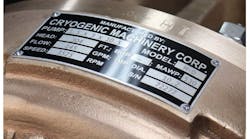BeyondTrucks expands integration hub
PSG acquires cryogenic pump manufacturer
Backed by new private equity firm, Grammer Industries finding fresh opportunities for growth, expansion
OVER roughly five decades, Grammer Industries Inc has grown into a diversified operation with a core focus on handling hazardous materials. The management team continues to pursue new opportunities for expansion and diversification.
From its new headquarters in Columbus, Indiana, the tank truck carrier directs operations spread across the eastern half of the United States. The company’s 150 company tractors and over 100 owner operators tractors and 350 tank trailers are dispersed among 11 terminals in nine states.
The fleet serves more than 120 customers transporting anhydrous ammonia, liquefied petroleum gas, carbon dioxide, nitric acid, cryogenic liquids, and other bulk hazardous liquids. A separate division—Vickery Transportation—specializes in hauling hazardous wastes. Transloading activities are steadily growing for the fleet.
“This company has achieved steady success over the decades because we welcome challenges and are willing to provide customers the services they want and need,” says John Whittington, vice-president of Grammer Industries. “We’re very optimistic about the future.
“Historically, Grammer Industries focused on slow and steady growth. That has changed now. With our new private equity owner—Stellex Capital Management—we have now developed a more aggressive strategy that combines organic growth and acquisition.
“We want to continue expanding our footprint beyond the eastern half of the United States. For instance, we’re developing opportunities in Texas.”
Bart Middleton, Grammer Industries chief executive officer, adds: “We are very excited about the opportunities offered by our partnership with Stellex and our shared vision for the next phase of growth at Grammer Industries. We have a demonstrated track record of growth, and we will continue to deepen our position as the industry’s logistics partner of choice.”
Newest acquisition
Proof that Grammer Industries and Stellex are indeed on the hunt for acquisitions came with the recent announcement that they had acquired Sterling Transport, a liquid and dry bulk hauler based in Vass, North Carolina. Sterling Transport hauls propane, natural gas liquids, cement, fly ash, asphalt, sand, and salt.
“The strategic combination of Grammer and Sterling greatly advances our vision to establish a leading US specialty logistics company,” Whittington says. “Our integration plan will leverage the relative strengths of both companies—and particularly the combined organization of over 500 drivers and owner-operators—to create a compelling value proposition for current and future customers.”
The combined business will have 22 terminals, 300 company tractors, 850 specialty trailers, and more than 500 drivers and owner-operators who will continue to support more than 2,000 delivery points serving more than 500 customers. As part of the transaction, Sterling’s founder, Hugh Hinton Jr, will continue to be an investor in the combined company.
Grammer history
Even before the Sterling Transport acquisition, Grammer Industries had become a very diversified operation. Over the decades, the Grammer Industries ownership had established a number of subsidiaries, including storage terminals and a biodiesel plant.
Grammer Industries was founded in 1968 by Charles “Shorty” Whittington in Grammer, Indiana, as an over-the-road transporter of grain and dry fertilizer serving the agricultural industry in Southeast Indiana. In 1977, the company entered the ammonia transport business through an acquisition that included the company’s first anhydrous ammonia tanker.
Through additional acquisitions in the late 1980s through the mid-1990s, Grammer entered into the nitric acid and power plant anhydrous ammonia trucking markets, further expanding its offerings and the industries it serves.
In 1999, the company founded a subsidiary, Vickery Transportation, which provides bulk liquid hazardous and non-hazardous waste transportation services. Grammer continued to position itself as a hazardous materials transport leader through strategic acquisitions throughout the 2000s. In 2007, the company extended its operations into the southeastern United States, opening a facility in Augusta, Georgia.
Private equity
In 2012, a private equity firm purchased a majority interest in Grammer Industries. That arrangement terminated in October 2018 when another private equity firm, Stellex, purchased ownership which included Grammer Industries and Vickery Transportation.
John and Shorty retained minority shares in the fleet operations. However, they retained full ownership of subsidiary operations, including two storage terminals, transloading operations, and a biodiesel plant.
“We sold to Stellex, because we felt it was the right time, and it gave Shorty an easier transition to retirement,” John says. “Grammer Industries was doing very well and had doubled in size over a recent four-year period.
Strong team
The connection to Stellex has given the tank truck carrier the ability to attract experienced management personnel with transportation, shipping, and business development backgrounds.
“We’ve built a team that has a lot of pride in the company,” John says. “We’re still adding more staff.”
Overall management of the operation is handled at the new headquarters in Columbus, which enabled Grammer Industries to consolidate all of the critical departments under a single roof.
“This is the first time we’ve had all of the administrative functions in one location in many years,” Middleton says. “We had outgrown the previous dispersed headquarters arrangement.”
While the carrier recently added two dispatchers in the Columbus office to help balance traffic lanes, most dispatch functions still reside with the terminals where tractors and trailers are based. Dispatchers use McLeod software to manage fleet activities.
“We’re installing the latest version of the McLeod system,” John says. “We have added data analysis to get the most out of the software.”
Busy fleet
Factors keeping the fleet busy include a continuing shift of anhydrous ammonia from rail transport to trucks even for some shipments in excess of 1,000 miles.
“We’ve also seen steady growth in propane shipments, and Grammer Industries is setting up transloading sites (primarily for propane) in selected markets in the Southeast,” John says. “Grammer now has transload sites in North Carolina, Tennessee, Georgia, and Florida.”
All drivers—company drivers and owner-operators—attend a three-day orientation at the Columbus headquarters when they join the carrier. “We want to make sure everyone understands that our commitment to safety and service excellence starts at the top of this company,” Middleton says.
To drive for Grammer Industries, a driver must be at least 23 years old and have a minimum of two years of verifiable over-the-road truck driving experience. The carrier requires cargo tank and hazardous materials endorsements.
“We also encourage drivers to obtain a TWIC (Transportation Worker Identification Credential),” says George Gerth, Grammer Industries Vice President of Safety and Driver Recruiting.
Driver orientation
During the orientation, instructors cover required Department of Transportation training, rollover prevention, and commercial driver license compliance. They introduce the drivers to the Infinity on-line safety training that is used for regular monthly training updates.
Following the orientation at the corporate headquarters, drivers receive another on to three weeks of on-the-job training at their home terminal.
The on-line training sessions cover general safety topics and company-specific issues, each video lasts three to eight minutes. The carrier sends out two to four videos each month.
Topics have included: Accident reporting; training on handling anhydrous ammonia, acids, CO2, nitrogen, and oxygen; hose inspections; and Truckers Against Human Trafficking.
Hands-on training during the orientation includes time spent with the Grammer Industries cut-away MC331 training trailer that has been used by the fleet since 1988. The carrier constructed the cut-away trailer for its own driver training programs, but customers and emergency responders also asked for the opportunity to train on the trailer.
Today, many chemical manufacturers/distributors have implemented Grammer’s training for their own personnel.
The carrier also has a couple of special wrapped trailers in the fleet that are used to help raise public awareness. A pink MC331 highlights breast cancer awareness, while another supports the Wounded Warrior program.
“Vendors have been very receptive to supporting these special trailer projects,” John says. “We donate the price of the trailer to the cause, and vendors supply trailer components. Drivers want to pull the trailers.”
As part of an effort to reward drivers for outstanding performance, Grammer Industries launched Driver of the Quarter and Driver of the Year programs. Brenda Law was the most recent recipient of the Driver of the Year award.
She was selected by top management for fantastic job performance, according to Gerth. In addition to an excellent safety record, she was a top revenue earner based on loads hauled.
Fleet specs
For company drivers, the newest tractors in the fleet are Peterbilt Model 579s with Cummins X15 engines and the 12-speed Cummins/Eaton Endurant automated transmission.
“We have a long-standing relationship with Cummins, and we are a test fleet for them,” John says. “We work closely with them on tweaking engines for performance and driver satisfaction.”
The newest tractors have the Bendix Wingman Fusion safety system that includes collision avoidance and lane-departure alerts. “We use Speed Gauge to monitor speeding, and we also monitor hard braking and roll stability alerts,” Gerth says.
Tractors also are specified with Lytx on-board cameras. In addition to a forward facing video camera inside the cab, Grammer Industries is mounting rear-facing cameras on the side mirrors.
“We believe we have everything in place to continue growing this company,” says Middleton. “We have the industry knowledge and enthusiasm. We have the financial backing. And we have an economy that still looks quite solid.”








